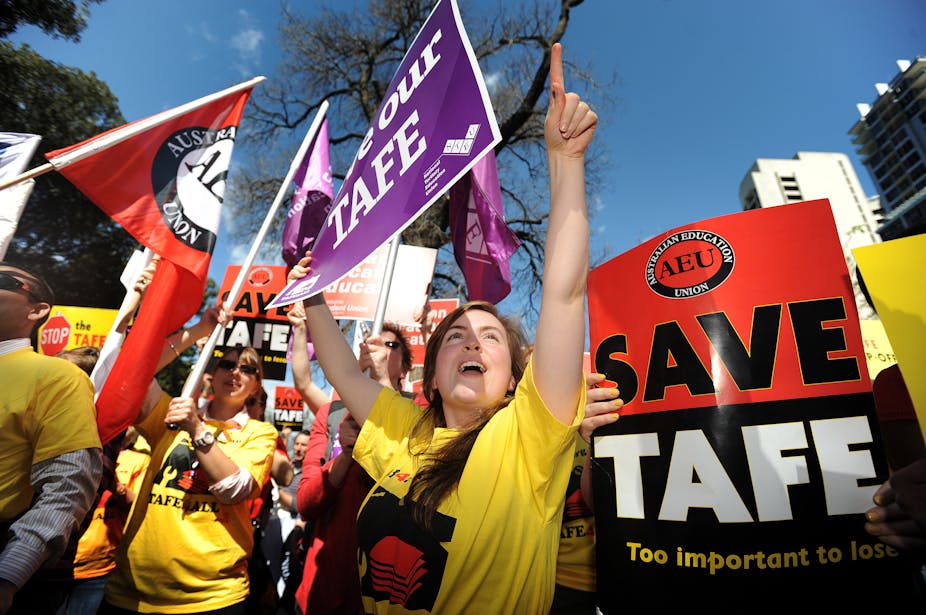On the eve of Good Friday, in apparent attempt to bury a bad news story, the Victorian government sacked seven of the chairs of its 14 standalone TAFEs and two more were to “retire”.
These sackings came as no surprise. In October last year, Victoria’s Coalition government shepherded through Parliament amendments to the Education and Training Reform Act which severely circumscribed the powers of TAFE governing boards and gave the minister the power to hire and fire chairs and board members.
Under previous arrangements, TAFE chairs were selected by the board members, half of whom were appointed on the recommendation of the skills minister.
As you would expect, the Victorian Labor opposition has roundly condemned the sackings, describing them as political payback for the outspoken criticism by the Victorian TAFE sector of last year’s dramatic cuts to TAFE funding, in favour of private VET providers.
But the irony is that in 2010 the then government, and now opposition, proposed more or less the same powers to hire and fire. Peter Hall, then opposition spokesperson, now higher education minister, said in 2010:
This is an unnecessary grab for power… The minister suggested there needed to be more lines of accountability because these institutes are engaging in commercial activities and as they receive significant funding from the taxpayer they need to be accountable to the taxpayer. They are already accountable, and they are already engaging in significant commercial activity.
But now Peter Hall says that this “grab for power” is necessary to make TAFE more “commercially oriented”, in line with the recommendations of the Report of the TAFE Reform Panel.
Well, the panel did advise a number of measures to make TAFE more “commercially oriented” but nowhere did it recommend wholesale board sackings.
While the government hasn’t given reasons for the sackings, one can reasonably assume that the chairs were dispatched because of a perceived lack of business expertise.
Peter Hall obviously has very high expectations.
Jonathon Forster, who Hall sacked as Holmesglen’s chair, is the founder and now executive chair of Kane Constructions, a company with an annual turnover of $500 million, 285 full time employees and which operates throughout the east coast of Australia and overseas.
And in his own seat covering the La Trobe Valley, Hall has sacked David Gittins as chair of GippsTAFE. Gittins is just the managing director of the Valley’s biggest car dealership and has a background in community service (he was, for example, the founding chairman of Life Education for Doncaster Templestowe in 1989-1992).
The government might have justified the sackings on the basis that the institutions themselves have somehow failed to realise commercial opportunities and have been poorly governed and managed.
The government didn’t make that case because it’s not one that can substantiated: all the evidence points the other way.
Data published by the National Centre for Vocational Education Research show that Victorian TAFE institutes have led the way in tapping non-government streams of revenue, which one could reasonably take to be an indicator of commercial orientation. In 2011, fee-for-service activity yielded Victorian TAFES $475.3 million in revenue, some 44% of the Australian TAFE sector total.
The larger Victorian TAFEs all have large offshore operations. Northern Melbourne Institute of TAFE (NMIT), for example, delivered programs outside Australia with 25 partner institutions, involving 23,000 students, in countries such as China, Hong Kong, South Korea, Singapore and Malaysia. NMIT’s total income in 2011 of $153.6 million included “extraneous”, mainly fee-for-service, income of $64 million (about 42% of the total).
NCVER data also show Victorian TAFEs to be the most “efficient” in terms of the composition of their expenditure: 68 cents of every dollar was on actual training provision and support as against an Australian average of 63 cents in the dollar.
And Victorian TAFEs aren’t remarkably profligate in benefits to staff: employee costs comprised 49.7% of expenditure as against an Australian TAFE sector total of 54.4% (university sector employee costs averaged 57.5% of overall expenditure in 2011).
You might think the TAFE Reform Panel would have looked at these sorts of issues in detail but, in what appears to be a classic case of policy-based evidence, the Panel only made passing reference to the comparative performance of Victoria’s TAFE sector (14 words on page 56, that I can find).
The Panel has recommended to the government that TAFEs need greater autonomy, including in capital raising and investment, to enable them to operate effectively in the “competitively neutral market” the government is putting in place. The government says it accepts this but, on the precept that you should start as you mean to go, sacking half the TAFE board chairs and foreshadowing a spill of all TAFE board positions seems not to be an auspicious beginning.
In the meantime, there’s the federal inquiry into TAFE, which has a remit to look at all aspects of the TAFE equation, including that increasingly quaint notion of the contribution that TAFE can make to community and personal development, which modern governments no longer seem prepared to fund.
The inquiry has called for submissions by Thursday 18 April 2013.
This inquiry provides an opportunity at a critical time in TAFEs history to properly define the role of the public VET provider in contributing to Australia’s continuing economic and social development. It also needs to set out, in broad terms, what is needed to support that role.
The overriding question before the inquiry is whether Australia can afford to allow the policy-driven descent of TAFE into a fractured, residualised system, with no apparent community purpose, as is seemingly occurring in Victoria.

